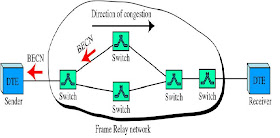Congestion-Control Mechanisms
Frame Relay reduces network overhead by implementing simple congestion-notification mechanisms rather than explicit, per-virtual-circuit flow control.Frame Relay typically is implemented on reliable network media, so data integrity is not sacrificed because flow control can be left to higher-layer protocols. Frame Relay implements two congestion-notification mechanisms:
- Forward-explicit congestion notification (FECN)
- Backward-explicit congestion notification (BECN)
FECN and BECN each is controlled by a single bit contained in the Frame Relay frame header. The Frame Relay frame header also contains a Discard Eligibility (DE) bit, which is used to identify less important traffic that can be dropped during periods of congestion.
- The FECN bit is part of the Address field in the Frame Relay frame header.The FECN mechanism is initiated when a DTE device sends Frame Relay frames into the network. If the network is congested, DCE devices (switches) set the value of the frames’ FECN bit to 1.

- The BECN bit is part of the Address field in the Frame Relay frame header.DCE devices set the value of the BECN bit to 1 in frames traveling in the opposite direction of frames with their FECN bit set.This informs the receiving DTE device that a particular path through the network is congested.

The Discard Eligibility (DE) bit is used to indicate that a frame has lower importance than other frames. The DE bit is part of the Address field in the Frame Relay frame header. DTE devices can set the value of the DE bit of a frame to 1 to indicate that the frame has lower importance than other frames.
Frame Relay error-checking
Frame Relay uses a common error-checking mechanism known as the cyclic redundancy check (CRC).The CRC compares two calculated values to determine whether errors occurred during the transmission from source to destination.Frame Relay reduces network overhead by implementing error checking rather than error correction.

No comments:
Post a Comment